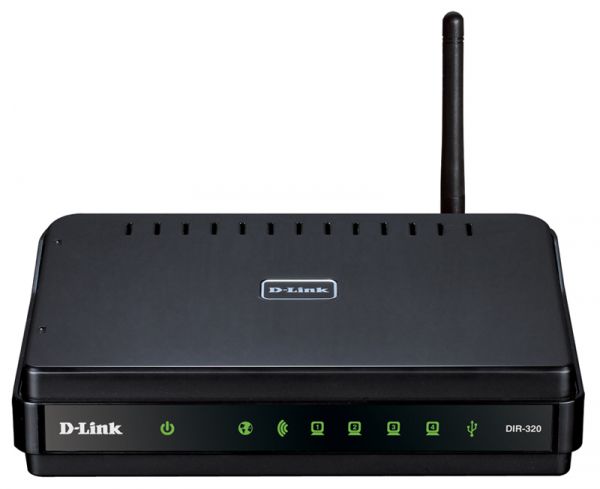
DIR-320/NRUEOL EOS
Multifunction Wireless Router Supporting WiMAX, 3G GSM/CDMA with Built-in Switch
Description
USB Port and INTERNET Port
The router is equipped with a USB port for a USB modem, which can be used to establish connection to the Internet via a WiMAX, 3G GSM or CDMA network. Also you are able to connect the multifunction wireless router DIR-320NRU to a cable or DSL modem or to a private Ethernet line and use a high-speed Internet connection to successfully fulfill a wide range of tasks.
4-port Switch
The built-in 4-port switch enables you to connect Ethernet-enabled computers, game consoles, and other devices to your network.
Security
The multifunction wireless router DIR-320NRU includes a built-in firewall. The advanced security functions minimize threats of hacker attacks, prevent unwanted intrusions to your network, and block access to unwanted websites for users of your LAN.
Wireless Interface
Using the DIR-320NRU device, you are able to quickly create a wireless network at home or in your office, which lets your relatives or employees connect to your wireless network virtually anywhere (within the operational range of your wireless network). The router is designed to work with 802.11n wireless devices (at the rate up to 150Mbps) and supports 802.11b/g wireless devices.
The router supports multiple functions for the wireless interface: several security standards (WEP, WPA/WPA2, IEEE 802.1X), MAC address filtering, different operation modes (access point, client, bridge), WPS, WMM.
Configuration and Management
You can configure and manage the settings of the multifunction wireless router DIR-320NRU via the user-friendly web-based interface (the interface is available in several languages).
General features
WAN Interface:
• 1 10/100BASE-TX Ethernet port for cable or DSL modem or private Ethernet line.
LAN Interface:
• 4 10/100BASE-TX Ethernet ports.
WLAN Interface:
• IEEE 802.11b/g/n.
USB Interface:
• USB 2.0 type A port for USB modem.
Data Rate:
• 802.11b: 11, 5.5, 2, and 1Mbps
• 802.11g: 54, 48, 36, 24, 18, 12, 9, and 6Mbps
• 802.11n: 6.5~150Mbps.
Receiver Sensitivity:
• 802.11b (typical at PER = 8% (1000-byte PDUs) at room temperature):
–86dBm at 11Mbps
–87dBm at 5.5Mbps
–88dBm at 2Mbps
–90dBm at 1Mbps
• 802.11g (typical at PER = 10% (1000-byte PDUs) at room temperature):
–84dBm at 6Mbps
–82dBm at 9Mbps
–80dBm at 12Mbps
–78dBm at 18Mbps
–77dBm at 24Mbps
–74dBm at 36Mbps
–70dBm at 48Mbps
–68dBm at 54Mbps
• 802.11n (typical at PER < 10% (1000-byte PDUs) at room temperature):
• HT20:
–93dBm at BPSK, coding rate 1/2 (MCS-0)
–90dBm at QPSK, coding rate 1/2 (MCS-1)
–88dBm at QPSK, coding rate 3/4 (MCS-2)
–85dBm at 16-QAM, coding rate 1/2 (MCS-3)
–82dBm at 16-QAM, coding rate 3/4 (MCS-4)
–78dBm at 64-QAM, coding rate 2/3 (MCS-5)
–77dBm at 64-QAM, coding rate 3/4 (MCS-6)
–76dBm at 64-QAM, coding rate 5/6 (MCS-7)
• HT40:
–90dBm at BPSK, coding rate 1/2 (MCS-0)
–87dBm at QPSK, coding rate 1/2 (MCS-1)
–85dBm at QPSK, coding rate 3/4 (MCS-2)
–82dBm at 16-QAM, coding rate 1/2 (MCS-3)
–79dBm at 16-QAM, coding rate 3/4 (MCS-4)
–75dBm at 64-QAM, coding rate 2/3 (MCS-5)
–74dBm at 64-QAM, coding rate 3/4 (MCS-6)
–73dBm at 64-QAM, coding rate 5/6 (MCS-7).
Frequency Range:
• 2.4~2.497MHz ISM band
Transmitter Output Power
• 802.11b:
– typical 17dBm (+/-2dB) at 11, 5.5, 2, and 1Mbps at 25 °C
• 802.11g:
– typical 17dBm (+/-2dB) at 6 to 36Mbps at 25 °C
– typical 16dBm (+/-2dB) at 48Mbps at 25 °C
– typical 15dBm (+/-2dB) at 54Mbps at 25 °C
• 802.11n:
– typical 16dBm (+/-2dB) at MCS0 to MCS2 at 25 °C
– typical 15dBm (+/-2dB) at MCS3 to MCS4 at 25 °C
– typical 13dBm (+/-2dB) at MCS5 and MCS7 at 25 °C.
EIRP (Effective Isotropic Radiated Power):
• 802.11b: 17dBm
• 802.11g: 16dBm
• 802.11n: 19dBm.
Software
Network Functions
• WAN connection types:
– 3G
– IPoE
– PPPoE
– PPTP
– L2TP
• DHCP server and client
• DNS relay
• VPN pass-through (PPTP)
• Support of VLAN
• Dynamic DNS
• Static IP routing
• Remote management
• Network statistics for each interface
• IGMP Proxy
• RIP
• UPnP
USB Modem
• Auto connection to available type of supported network (3G/2G)
• Enabling/disabling PIN code check, changing PIN code
Wireless Connection
• WLAN splitting (up to 4 SSIDs)
• Supported security settings
– WEP
– WPA/WPA2 Personal
– WPA/WPA2 Enterprise
– IEEE 802.1X
• MAC filter
• Managing connected stations
• PIN and PBC methods of WPS
• WMM (Wi-Fi QoS)
• Advanced settings
• WDS
• Support of client mode
Firewall Functions
• Network Address Translation (NAT)
• Stateful Packet Inspection (SPI)
• IP filters
• URL filter
• MAC filter
• DMZ
• Prevention of ARP and DDoS attacks
• Virtual servers.
Configuration and Management:
• Multilingual web-based interface for configuration and management
• Access via TELNET
• Firmware update via web-based interface
• Saving/restoring configuration to/from file
• Support of remote logging
• Automatic synchronization of system time with NTP server
Supported USB Modems:
• GSM modems:
– Huawei E150
– Huawei E1550
– Huawei E160G
– Huawei E169G
– Huawei E173
– Huawei E220
– ZTE MF626
– ZTE MF627
• CDMA modems:
– Anydata ADU-500A
– Celot CT-650
• WiMAX modem:
– Samsung SWC-U200 (firmware version u200_rev1-2.7.40-CI14)
Physical and Environmental
LEDs:
• Power
• Internet
• WLAN
• 4 LAN LEDs
• USB
• WPS
Power:
• External power adapter DC 5V/2А
• Reset to Factory Defaults button.
Operating Temperature:
• from 0 to 40 0C (from 32 to 104 0F)
Storage Temperature:
• from -20 to 65 0С (from -4 to 149 0F)
Operating Humidity:
• from 10% to 90% non-condensing
Storage Humidity:
• from 5% to 95% non-condensing
Certificates
Order info
DIR-320NRU Multifunction Wireless Router Supporting WiMAX, 3G GSM/CDMA with Built-in Switch

